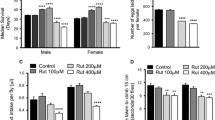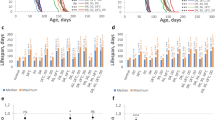Abstract
Organismal lifespan is a complex trait that is governed by both its genetic makeup as well as the environmental conditions. The improved socioeconomic condition of humans has led to many lifestyle changes that in turn have altered the demography that includes postponement of procreation. Late age progeny is shown to suffer from many congenital diseases. Hence, there is a need to identify and evaluate natural molecules that could enhance reproductive health span. We have used the well-established model organism, Drosophila melanogaster, and ascertained the consequence of diet supplementation with curcumin. Flies reared on curcumin-supplemented diet had significantly higher lifespan. The progeny of flies reared on curcumin had a higher viability. The activity of a key mitochondrial enzyme—aconitase was significantly higher in flies reared on curcumin-supplemented diet. The results suggest that curcumin can not only correct a key step in the citric acid cycle and help in the release of additional energy but also permanently correct developmental and morphogenetic processes.










Similar content being viewed by others
Abbreviations
- DR:
-
Diet restriction
- SM:
-
Standard banana-jaggery medium
- SLC:
-
Standard laboratory conditions
- RT:
-
Room temperature
- PC:
-
Parental fly cage
- FC:
-
Progeny fly cage
- FA :
-
Progeny raised on SM
- FB :
-
Progeny raised on SM supplemented with 5 μM curcumin
- FC :
-
Progeny raised on SM supplemented with 10 μM curcumin
- FD :
-
Progeny raised on SM supplemented with 25 μM curcumin
- FE :
-
Progeny raised on SM supplemented with 50 μM curcumin
References
Araki T, Sasaki Y, Milbrandt J (2004) Increased nuclear NAD biosynthesis and SIRT1 activation prevent axonal degeneration. Science 305:1010–1013
Arrese EL, Soulages JL (2010) Insect fat body: energy, metabolism, and regulation. Annu Rev Entomol 55:207–255
Arrese EL, Patel RT, Soulages JL (2006) The main triglyceride-lipase from the insect fat body is an active phospholipase A(1): identification and characterization. J Lipid Res 47:2656–2667
Barzegar A, Moosavi-Movahedi AA (2011) Intracellular ROS protection efficiency and free radical-scavenging activity of curcumin. PLoS ONE 6(10):e26012. doi:10.1371/journal.pone.0026012
Caesar I, Jonson M, Nilsson KPR, Thor S, Hammarström P (2012) Curcumin promotes A-beta fibrillation and reduces neurotoxicity in transgenic Drosophila. PLoS ONE 7(2):e31424. doi:10.1371/journal.pone.0031424
Carey JR (2003) Life span: a conceptual overview. In: Carey JR, Tuljapurkar S (eds) Life span: evolutionary, ecological, and demographic perspectives. Population Council and Development Review 29(Suppl):1–18
Carlson KA, Harshman LG (1999) Extended longevity lines of Drosophila melanogaster: characterization of oocyte stages and ovariole numbers as a function of age and diet. J Gerontol A Biol 54:B432–B440
Chandrashekara KT, Shakarad MN (2011) Aloe vera or resveratrol supplementation in larval diet delays adult aging in the fruit fly, Drosophila melanogaster. J Gerontol A Biol Sci Med Sci 66(9):965–971
Chapman T, Partridge L (1996) Female fitness in Drosophila melanogaster: an interaction between the effect of nutrition and of encounter rate with males. Proc R Soc Lond B Biol Sci 263:755–759
Chippindale AK, Leroi AM, Kim SB, Rose MR (1993) Phenotypic plasticity and selection in Drosophila life history evolution. 1. Nutrition and the cost of reproduction. J Evol Biol 6:171–193
Clark AG, Keith LE (1988) Variation among extracted lines of Drosophila melanogaster in triacylglycerol and carbohydrate storage. Genetics 119:595–607
Das N, Levine RL, Orr WC, Sohal RS (2001) Selectivity of protein oxidative damage during aging in Drosophila melanogaster. Biochem J 360:209–216
Dong Y, Guha S, Sun X, Cao M, Wang X, Zou S (2012) Nutraceutical interventions for promoting healthy aging in invertebrate models. Oxidative Med Cell Longev. doi:10.1155/2012/718491
Eisenberg T, Knauer H, Schauer A, Büttner S, Ruckenstuhl C, Carmona-Gutierrez D, Ring J, Schroeder S, Magnes C, Antonacci L, Fussi H, Deszcz L, Hartl R, Schraml E, Criollo A, Megalou E, Weiskopf D, Laun P, Heeren G, Breitenbach M, Grubeck-Loebenstein B, Herker E, Fahrenkrog B, Fröhlich KU, Sinner F, Tavernarakis N, Minois N, Kroemer G, Madeo F (2009) Induction of autophagy by spermidine promotes longevity. Nat Cell Biol 11(11):1305–1314
Fisher LD, van Belle G (1993) Biostatistics: a methodology for health sciences. Wiley, New York, pp 786–843
Grandison RC, Piper MD, Partridge L (2009) Amino-acid imbalance explains extension of lifespan by dietary restriction in Drosophila. Nature 462:1061–1064
Han YS, Zheng WH, Bastianetto S, Chabot JG, Quirion R (2004) Neuroprotective effects of resveratrol against beta-amyloid-induced neurotoxicity in rat hippocampal neurons: involvement of protein kinase C. Br J Pharmacol 141:997–1005
Handa J, Chandrashekara KT, Kashyap K, Sageena G, Shakarad MN (2014) Gender based disruptive selection maintains body size polymorphism in Drosophila melanogaster. J Biosci 39:609–620. doi:10.1007/s12038-014-9452-x
Heinrichsen ET, Zhang RJE, Ngo J, Diop S, Bodmer R, Joiner WJ, Metallo CM, Haddad GG (2013) Metabolic and transcriptional response to a high-fat diet in Drosophila melanogaster. Mol Metabol 3:42–54. doi. 10.1016/j.molmet.2013.10.003
Hercus MJ, Hoffmann AA (2000) Maternal and grandmaternal age influence offspring fitness in Drosophila. Proc R Soc Lond B 267:2105–2110
Howitz KT, Bitterman KJ, Cohen HY, Lamming DW, Lavu S, Wood JG, Zipkin RE, Chung P, Kisielewski A, Zhang LL, Scherer B, Sinclair DA (2003) Small molecule activators of sirtuins extend Saccharomyces cerevisiae lifespan. Nature 425:191–196
Iijima K, Zhao L, Shenton C, Iijima-Ando K (2009) Regulation of energy stores and feeding by neuronal and peripheral CREB activity in Drosophila. PLoS ONE 4(12):e8498. doi:10.1371/journal.pone.0008498
Kennedy MC, Emptage MH, Dreyer JL, Beinert H (1983) The role of iron in activation-inactivation of aconitase. J Biol Chem 258:11098–11105
Kenyon CJ (2010) The genetics of aging. Nature 464:504–512
Kern S, Ackermann M, Stearns SC, Kawecki TJ (2001) Decline in offspring viability as a manifestation of aging in Drosophila melanogaster. Evolution 55(9):1822–1831
Lee KS, Lee BS, Semnani S, Avanesian A, Um CY, Jeon HJ, Seong KM, Yu K, Min KJ, Jafari M (2010) Curcumin extends lifespan, improves health span, and modulates the expression of age-associated aging genes in Drosophila melanogaster. Rejuvenation Res 13(5):561–570
Li YM, Chan HYE, Huang Y, Chen ZY (2007) Green tea catechins upregulate superoxide dismutase and catalase in fruit flies. Mol Nutri Food Res 51(5):546–554
Li YM, Chan HYE, Yao XQ, Huang Y, Chen ZY (2008) Green tea catechins and broccoli reduce fat-induced mortality in Drosophila melanogaster. J Nutri Biochem 19(6):376–383
Martin I, Grotewiel MS (2006) Oxidative damage and age related functional declines. Mech Ageing Dev 127(5):411–423
Mercken EM, Crosby SD, Lamming DW, JeBailey L, Krzysik-Walker S, Villareal DT, Capri M, Franceschi C, Zhang Y, Becker K, Sabatini DM, de Cabo R, Fontana L (2013) Calorie restriction in humans inhibits the PI3K/AKT pathway and induces a younger transcription profile. Aging Cell 12:645–651
Mokni M, Elkahoui S, Limam F, Amri M, Aouani E (2007) Effect of resveratrol on antioxidant enzyme activities in the brain of healthy rat. Neurochem Res 32:981–987
Nojima A, Yamashita M, Yoshida Y, Shimizu I, Ichimiya H, Kamimura N, Kobayashi Y, Ohta S, Ishii N, Minamino T (2013) Haploinsufficiency of Akt1 prolongs the lifespan of mice. PLoS ONE 8(7):e69178
Nygaard M, Soerensen M, Flachsbart F, Mengel-From J, Tan Q, Schreiber S, Nebel A, Christensen K, Christiansen L (2013) Akt1 fails to replicate as a longevity-associated gene in Danish and German nonagenarians and centenarians. Eu J Human Genet 21:574–577
Palanker L, Tennessen JM, Lam G, Thummel CS (2009) Drosophila HNF4 regulates lipid mobilization and beta-oxidation. Cell Metab 9(3):228–239
Parker JA, Arango M, Abderrahmane S, Lambert E, Tourette C, Catoire H, Néri C (2005) Resveratrol rescues mutant polyglutamine cytotoxicity in nematode and mammalian neurons. Nat Genet 37:349–350
Partridge L, Gems D (2002) Mechanisms of ageing: public or private? Nature Rev Genet 3:165–175
Partridge L, Piper MDW, Mair W (2005) Dietary restriction in Drosophila. Mech Ageing Dev 126:938–950
Patel RT, Soulages JL, Hariharasundaram B, Arrese EL (2005) Activation of the lipid droplet controls the rate of lipolysis of triglycerides in the insect fat body. J Biol Chem 280:22624–22631
Peng C, Zuo Y, Kwan KM, Liang Y, Ma KY, Chan HYE, Huang Y, Yu H, Chen ZY (2012) Blueberry extract prolongs lifespan of Drosophila melanogaster. Exp Gerontol 47(2):170–178
Sahin E, DePinho RA (2010) Linking functional decline of telomeres, mitochondria and stem cells during aging. Nature 464:520–528
Schatten H, Chakrabarti A, Hedrick J (1999) Centrosome and microtubule instability in aging Drosophila cells. J Cell Biochem 74:229–241
Shanley DP, Kirkwood TBL (2000) Calorie restriction and aging: a life-history analysis. Evolution 54(3):740–750
Shen LR, Xiao F, Yuan P, Chen Y, Gao QK, Parnell LD, Meydani M, Ordovas JM, Li D, Lai CQ (2012) Curcumin-supplemented diets increase superoxide dismutase activity and mean lifespan in Drosophila. Age. doi:10.1007/s11357-012-9438-2
Soh JW, Marowsky N, Nichols TJ, Rahman AM, Miah T, Sarao P, Khasawneh R, Unnikrishan A, Heydari AR, Silver RB, Arking R (2013) Curcumin is an early-acting stage specific inducer of extended functional longevity in Drosophila. Exp Gerontol 48:229–239
Sokal RR, Rohlf JF (1995) Biometry: the principles and practices of statistics in biological sciences. WH Freeman, New York, pp 179–450
Song G, Ouyang G, Bao S (2005) The activation of Akt/PKB signaling pathway and cell survival. J Cell Mol Med 9:59–71
Steele JE (1982) Glycogen-phosphorylase in insects. Insect Biochem 12:131–147
Tatar M, Post S, Yu K (2014) Nutrient control of Drosophila longevity. TEM. http://dx.doi.org/10.1016/j.tem.2014.02.006
Tu MP, Tatar M (2003) Juvenile diet restriction and the aging and reproduction of adult Drosophila melanogaster. Aging Cell 2:327–333
Valko M, Leibfritz D, Moncol J, Cronin MT, Mazur M, Telser J (2007) Free radicals and antioxidants in normal physiological functions and human disease. Int J Biochem Cell B 39(1):44–84
Vaupel JW (2010) Biodemography of human aging. Nature 464:536–542
Wang Q, Xu J, Rottinghaus GE, Simonyai A, Lubahn D, Sun GY, Sun AY (2002) Resveratrol protects against global cerebral ischemic injury in gerbils. Brain Res 958:439–447
Wang Q, Yu S, Simonyai A, Rottinghaus GE, Sun GY, Sun AY (2004) Resveratrol protects against neurotoxicity induced by kainic acid. Neurochem Res 29:2105–2112
Wang C, Wheeler CT, Alberico T, Sun X, Seeberger J, Laslo M, Spangler E, Kern B, de Cabo R, Zou S (2013) The effect of resveratrol on lifespan depends on both gender and dietary nutrient composition in Drosophila melanogaster. Age 35:69–81. doi:10.1007/s11357-011-9332-3
Wood JG, Rogina B, Lavu S, Howitz K, Helfand SL, Tatar M, Sinclair D (2004) Sirtuin activators mimic caloric restriction and delay ageing in metazoans. Nature 430:686–689
Yarian CS, Toroser D, Sohal RS (2006) Aconitase is the main functional target of aging in the citric acid cycle of kidney mitochondria from mice. Mech Age Dev 127:79–84
Zid BM, Rogers AN, Katewa SD, Vargas MA, Kolipinski MC, Lu TA, Benzer S, Kapahi P (2009) 4E-BP extends lifespan upon dietary restriction by enhancing mitochondrial activity in Drosophila. Cell 139:149–160
Acknowledgments
We thank two anonymous referees for their helpful comments on the earlier versions of the manuscript and suggesting additional experiments on pAkt/Akt ratio and fat metabolism related genes. We also thank Dr. Rajesh Rajaiah, Department of Microbiology and Immunology, University of Maryland, USA, for providing us the pAKT antibody; Dr. Rajagopal Raman, Gut Biology Laboratory, Department of Zoology, University of Delhi; Dr. K. Natarajan, Ambedkar Centre for Biomedical Research, University of Delhi for providing the chemicals, buffers, and instruments required in Akt/pAkt, AKHR, and CG9510 Western blot and PCR experiments; and Ms. Nalini Mishra and numerous research trainees for their assistance in the research. MS thanks the University of Delhi and Council of Scientific and Industrial Research, Government of India, for financial assistance. SP thanks the University Grants Commission, Government of India, for DSKPDF fellowship.
Conflict of interest
The authors declare no conflict of interest.
Author contributions
K.T.C., S.P., and M.S. designed the research; K.T.C and S.P. performed the research; and K.T.C., S.P., and M.S. analyzed the data and wrote the paper.
Author information
Authors and Affiliations
Corresponding author
About this article
Cite this article
Chandrashekara, K.T., Popli, S. & Shakarad, M.N. Curcumin enhances parental reproductive lifespan and progeny viability in Drosophila melanogaster . AGE 36, 9702 (2014). https://doi.org/10.1007/s11357-014-9702-8
Received:
Accepted:
Published:
DOI: https://doi.org/10.1007/s11357-014-9702-8




